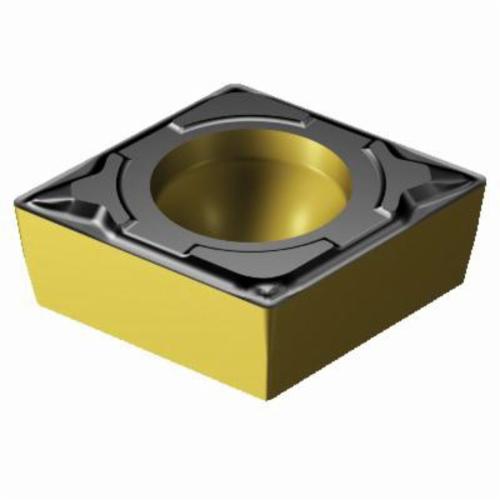or to view stock quantity and your pricing.
Steiner serves territories in Northern Illinois, Northwest Indiana and Southern Wisconsin. Please for assistance if outside our sales territory.
Sandvik Coromant 6612564 CoroTurn® 111 Turning Insert, CPMT 2(1.5)1-PF 4315, C-80 deg Diamond, CPMT Insert, 4315
Custom_Product_Images_Illustration
Sandvik Coromant 6612564 CoroTurn® 111 Turning Insert, CPMT 2(1.5)1-PF 4315, C-80 deg Diamond, CPMT Insert, 4315
SKU893795
MFGR #6612564
Your Cost: $13.33/ea
List: Sandvik Coromant Turning Insert, Series: CoroTurn® 111, CPMT Insert, C-80 deg Diamond, 1.5 mm Maximum Depth of Cut, 1/4 in Inscribed Circle, 0.0937 in Thickness, 0.2538 in Length, PF Chipbreaker, 0.0156 in Corner Radius, 0.1102 in Hole Dia, Manufacturer's Grade: 4315, ANSI Code: CPMT 2(1.5)1-PF 4315, ISO Code: CPMT 06 02 04-PF 4315, 80 deg Included Angle, 11 deg Relief Angle, Neutral Hand, Carbide, MTCVD Coated, Material Grade: K/P
Sandvik Coromant Turning Insert, Series: CoroTurn® 111, CPMT Insert, C-80 deg Diamond, 1.5 mm Maximum Depth of Cut, 1/4 in Inscribed Circle, 0.0937 in Thickness, 0.2538 in Length, PF Chipbreaker, 0.0156 in Corner Radius, 0.1102 in Hole Dia, Manufacturer's Grade: 4315, ANSI Code: CPMT 2(1.5)1-PF 4315, ISO Code: CPMT 06 02 04-PF 4315, 80 deg Included Angle, 11 deg Relief Angle, Neutral Hand, Carbide, MTCVD Coated, Material Grade: K/P
Alternate Catalog Number CPMT 2(1.5)1-PF 4315 ANSI Code CPMT 2(1.5)1-PF 4315 Catalog Number 6612564 Corner Radius 0.0156 in Country of Origin SE Finish MTCVD Coated Gross Weight Per Pack 1 lb Hand of Insert Neutral Hole Diameter 0.1102 in Included Angle 80 deg ISO Code CPMT 06 02 04-PF 4315 Item Group 122 Length 0.2538 in Relief Angle 11 deg Series CoroTurn® 111 Thickness 0.0937 in Type CoroTurn® 111 Width 0.396 mm Stock Status NONSTOCK Brand Sandvik Coromant Manufacturer Sandvik Coromant Chipbreaker PF Inscribed Circle 1/4 in Insert Size 1.5 mm Insert Style CPMT Manufacturer's Grade 4315 Material Carbide Material Grade K/P Maximum Depth of Cut 1.5 mm Shape C-80 deg Diamond 40 - 60 deg countersunk hole and non-flat surface clamping interface 1-side cutting +/-0.13 mm THK and +/-0.05 mm inscribed circle tolerance ER treated cutting edge Solid carbide is extremely heat-resistant and used for high speed applications on cast iron, non-ferrous materials, plastics and other tough-to-machine materials For optimized internal turning operations requiring small cutting forces The positive insert shape combines low cutting forces with good edge strength The screw clamping ensures stability and unobstructed chip flow 0.04 - 0.18 mm/r cutting feed 20 life cycle state
content loaded
content loaded
content loaded
content loaded
- Attributes
- Documents & Resources
- Features
- Substitute Products
| Alternate Catalog Number | CPMT 2(1.5)1-PF 4315 |
| ANSI Code | CPMT 2(1.5)1-PF 4315 |
| Catalog Number | 6612564 |
| Corner Radius | 0.0156 in |
| Country of Origin | SE |
| Finish | MTCVD Coated |
| Gross Weight Per Pack | 1 lb |
| Hand of Insert | Neutral |
| Hole Diameter | 0.1102 in |
| Included Angle | 80 deg |
| ISO Code | CPMT 06 02 04-PF 4315 |
| Item Group | 122 |
| Length | 0.2538 in |
| Relief Angle | 11 deg |
| Series | CoroTurn® 111 |
| Thickness | 0.0937 in |
| Type | CoroTurn® 111 |
| Width | 0.396 mm |
| Stock Status | NONSTOCK |
| Brand | Sandvik Coromant |
| Manufacturer | Sandvik Coromant |
| Chipbreaker | PF |
| Inscribed Circle | 1/4 in |
| Insert Size | 1.5 mm |
| Insert Style | CPMT |
| Manufacturer's Grade | 4315 |
| Material | Carbide |
| Material Grade | K/P |
| Maximum Depth of Cut | 1.5 mm |
| Shape | C-80 deg Diamond |
| 40 - 60 deg countersunk hole and non-flat surface clamping interface |
| 1-side cutting |
| +/-0.13 mm THK and +/-0.05 mm inscribed circle tolerance |
| ER treated cutting edge |
| Solid carbide is extremely heat-resistant and used for high speed applications on cast iron, non-ferrous materials, plastics and other tough-to-machine materials |
| For optimized internal turning operations requiring small cutting forces |
| The positive insert shape combines low cutting forces with good edge strength |
| The screw clamping ensures stability and unobstructed chip flow |
| 0.04 - 0.18 mm/r cutting feed |
| 20 life cycle state |
